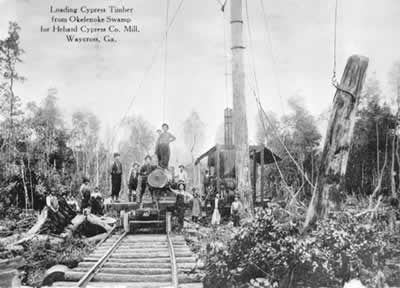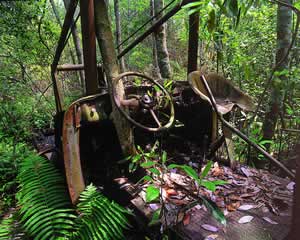
The Natural Georgia Series: The Okefenokee Swamp

 |
The Natural Georgia Series: The Okefenokee Swamp |
 |
After the Suwanee Canal Company failed in 1897, Joel Hurt of Atlanta was appointed
by the court as receiver to manage the bankrupt company. He was unable to operate
the company profitably. The property was sold to members of the Henry Jackson
and Henry R. Jackson family in 1899 as part of the Jackson Trust.
In 1901, the Jacksons sold the property to Charles S. Hebard of Philadelphia,
Pennsylvania. Additional lands in and around the Okefenokee were purchased by
Hebard in 1902. Mr. Hebard was one of the nation's prominent lumbermen. The
reign of the "cypress kings" began. It lasted approximately 40 years
in the Okefenokee Swamp. The Hebard era had a powerful impact on the swamp,
its people, and the surrounding area.
Unlike the ill-fated Suwanee Canal Company, the Hebards did not attempt to
drain the swamp. They set their sights solely on a lumbering operation. But
Charles S. Hebard died in 1902, before his plans for the Okefenokee materialized.
His property passed to his children. Charles Hebard of Thomasville, Georgia
and Daniel Hebard of Philadelphia were also experienced lumbermen. The Hebards
had conducted successful timber operations in Michigan for years. They organized
the Hebard Lumber Company of Thomas County, Georgia in 1904 with Charles Hebard
as president and Daniel Hebard as secretary. But the new company did not begin
operations until 1909.
A separate company, the Hebard Cypress Company, was incorporated under the
laws of West Virginia in 1907. On December 6, 1909, the Hebard Lumber Company
leased 219,500 acres of forested swamp land to the Hebard Cypress Company. The
owners of the Hebard Lumber Company were the principal owners of the Hebard
Cypress Company, but J.W. Oakford was elected president. The Hebard Lumber Company
was a holding company for several corporations. The Hebard Cypress Company was
a timber cutting and processing operation.
Prior to beginning logging operations in the Okefenokee, the Hebards had a
property survey and two timber surveys completed in 1901 and 1902. John M. Hopkins,
a young lawyer and civil engineer from Darien, Georgia did one of these surveys
in 1901. In 1905 he was employed and sent to Michigan to study the Hebard's
lumbering operation. Hopkins then served as superintendent of Hebard Cypress
Company operations until 1920. In 1909, Hopkins planned and built the Hebardville
sawmill, the railroad line into the swamp, and the logging camp at Hopkins and
the old camp at Cane Creek. He also managed the logging operations in the swamp.
He later planned and built the logging camp on Billys Island in 1917 and 1918.
After stepping down as superintendent, he was employed as an agent for the Hebard
Lumber Company. A.J. Armstrong was appointed superintendent of Hebard Cypress
Company operations in 1920.

One of the subsidiaries of the Hebard Lumber Company was a railroad, the Waycross
and Southern. It ran from Hebardville near Waycross to Hopkins on the northwestern
edge of the Okefenokee. This railroad carried timber from the swamp to the sawmill
at Hebardville. It also hauled turpentine, crossties, and other produce from
and to stations along the line. From Hopkins, initially the railroad was extended
southwestward to the old logging camp near the mouth of Cane Creek, and from
there southwestward into the cypress timber in the swamp. The railroad was built
on piling, a bridge above the peaty surface. This logging operation lasted from
1909 until 1912, when another piling railroad was extended south from Hopkins
to Cravens Hammock. Temporary spur logging tram railroads were extended from
the main lines into dense stands of cypress timber. When the timber was cut,
the rails were removed and used to build another spur line into another stand
of cypress further down the line. Small railroad locomotives moved slowly along
the unsteady rails, hauling the logs to the mill. Several steam-powered pile
drivers and steam-powered logging skidders were used to harvest several trainloads
of logs a day for the big sawmill at Hebardville.
The lumber produced by the Hebard Cypress Company was sold around the world.
The Pine Plume Lumber Company, a marketing firm in Savannah, was employed to
sell the Hebard Cypress Company lumber.
The pine timber on Billys, Minnies, Honey, Blackjack and several other islands
was leased to Twin Tree Lumber Company of Alabama in 1915. When the Hebards
established the logging camp on Billys Island in 1918, Twin Tree Lumber Company
moved to Hopkins and built a sawmill and quarters. Twin Tree also built a logging
camp on Jones Island and at the end of The Pocket at this time. Using the Hebard
Cypress Company railroad from Jones Island to Hopkins, Twin Tree systematically
cut and processed the pine timber in the swamp.
Meanwhile, Twin Tree subleased turpentine rights on their islands to Darling Turpentine Company of Alabama. This company built a turpentine still and quarters on Billys Island, two miles south of the logging camp. Gum was harvested prior to cutting the pines for lumber. Darling continued the turpentine operation until 1921. Turpentine leases on lands along the northern rim of the swamp were also sold to the Tatums, a turpentine firm in Ware County.
Systematically, the Hebards extended their logging operations across the Okefenokee.
Extending south from Hopkins to Cravens Island in 1912, they reached Pine Island
and Mixons Hammock by 1915. Within a year they were cutting the timber between
Mixons Hammock and Minnies Island and the railroad was extended across Jones
Island to Billys Island. By 1918, the logging camp was established on Billys
Island. About two years were required to log the timber around Billys Island.
By 1921, the company was building the railroad to Floyds Island. Between 1922
and 1926, they logged the cypress around Floyds Island.
The Hebard Cypress Company also conducted cypress logging operations northwest
of Waycross and in Arabia Bay northwest of Homerville.
Meanwhile, Twin Tree Lumber Company logged the timber on Minnies Island, on
and near The Pocket, on Billys Island and Honey Island, and the company built
a railroad to Blackjack Island and Mitchells Island. They discontinued their
logging operations and closed their sawmill at Hopkins in 1926.
The pine timber on Floyds Island was logged in 1925. By this time most of
the profitable timber had been cut and the Hebards were beginning to close down
their logging operations in the center of the swamp. They abandoned the logging
camp on Billys Island in 1926.
While the Hebards were withdrawing from the center of the swamp, they established
a logging camp on the railroad just north of Hopkins and logged the cypress
in the northern swamp. Their logging railroad reached almost to Dinner Pond
in 1927. They closed their sawmill at Hebardville in 1927 and discontinued their
logging operations.
The total investment made by the Hebards in the operation was approximately
$2 million. Four hundred and twenty-five million board feet of timber were cut
and hauled out of the Okefenokee. This was said to be enough to build 42,000
homes. Most of the trees cut were cypress and some magnificent specimens were
over 900 years old. Tens of thousands of railroad crossties were cut. The Hebards
had a very profitable business, but by 1927 the housing depression and diminishing
timber brought an end to the operations.
The reign of the Hebards caused great changes in the Okefenokee Swamp. Billys
Island, the home of the Lee family for two generations, was transformed into
a bustling "boom town" of 600 people. Lumbermen, railroaders, turpentiners,
and new technology penetrated the deepest reaches of the Okefenokee. The town
of Billys Island contained a sawmill, general store, schools, churches, a machine
shop, hotels, cafes, and even a movie. Families also listened to the radio on
Billys Island.
A variety of people worked for the Hebard Cypress Company. Experienced local
loggers, young men from south Georgia, and employees from Michigan who were
experienced lumberjacks were hired. Highly skilled workers were employed to
operate the expensive equipment used in the timber operation. Mr. Armstrong,
the superintendent, was English.
During the 1920s some 2,000 workers were conducting some type of lumbering,
crosstie, or turpentine operation in the Okefenokee.
During the 1920s and 1930s, especially after 1929 when the Hebard Cypress
Company gave up their lease to timber in the swamp, the Hebard Lumber Company
leased small tracts of timber through their agent John M. Hopkins. Many small
lumber companies gleaned most of the remaining cypress timber during this period.
Before the railroad to Floyds Island was removed, Daniel Hebard built a hunting
cabin on the island and employed Billy Spaulding as caretaker. Mr. Spaulding
lived alone in a small cabin near the hunting cabin from 1925 until 1937. Mr.
Hebard and his family hunted and fished and entertained their friends at this
retreat deep in the heart of the Okefenokee.
At the same time the Hebards were logging the former Suwanee Canal Company
lands, other companies were logging timber in other lands in the Okefenokee.
The largest, the Americus Manufacturing Company, bought a large tract of timber
in the southwestern area of the swamp; built piling railroads; and through the
Frank Snell Lumber Company and Council Lumber Company, logged the cypress and
processed it at the sawmill and logging camp at Council south of Fargo. They
also carried on an extensive crosstie and turpentine operation. They operated
between 1910 and 1926.
The Braganza Lumber Company logged the cypress and pines in the northern swamp
on and west of Cowhouse Island during the 1920s. This mill closed in 1926. During
the 1930s Johnson and Sons Lumber Company built several mills along the eastern
edge of the swamp and built railroads into the swamp to log timber leased from
the Hebard Lumber Company and K-3-S Lumber Company. Scott-Kendrick Lumber Company
also built railroads and harvested cypress timber in the eastern prairies of
the Okefenokee. There were many other small firms at work in the swamp during
the 1930s, logging and cutting crossties. It is possible that, altogether, they
cut as much timber as the Hebard Cypress Company. They also built as much piling
railroad in the swamp as the Hebards.
The Hebard era in the Okefenokee ended in 1937. The family sold the property
to the U.S. government. This paved the way for yet another era in the swamp
-- one that continues to this day. After decades of efforts to alter the swamp,
the Okefenokee was finally appreciated and preserved for what it is - a unique
resource and a magnificent natural landscape. The Okefenokee National Wildlife
Refuge was created in 1937 - the conservation era began.
--- For other accounts of the Hebard operations, see Robert L. Izlar, "A History of Okefenokee Logging Operations: A Bourbon and Branch Water Success Story," in A.D. Cohen, et al., The Okefenokee Swamp: Its Natural History, Geology, and Geochemistry (Los Alamos, NM: Wetland Surveys, 1984) pp. 5-17 and C.T. Trowell with Lorraine Fussell, "Exploring the Okefenokee: Railroads of the Okefenokee Realm," Research Paper No. 6, 1995 (in press).
Read and add comments about this page
Go back to previous page. Go to Okefenokee Swamp contents page. Go to Sherpa Guides home.
[ Previous Topic | Next Topic ]